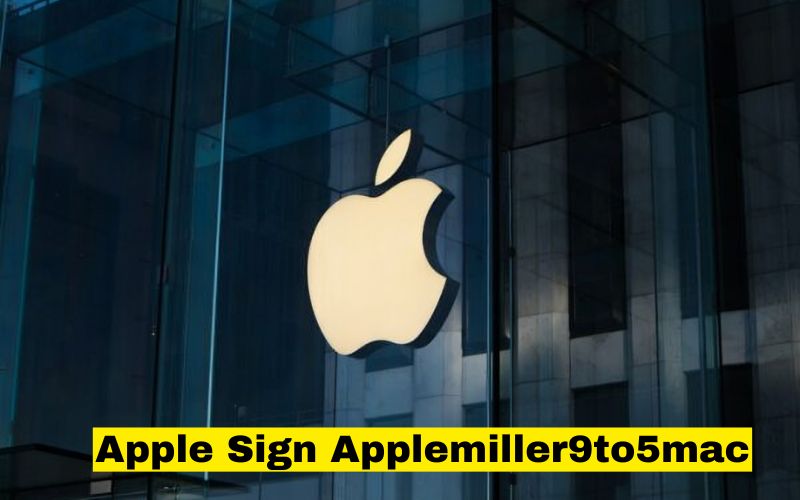The name “Apple Sign” has caught the attention of many tech enthusiasts, and one associated with this is “AppleMiller9to5Mac.” In this article, we will explore what “Apple Sign” could signify, delve into the history of Apple’s identity features, and discuss the role of sources such as 9to5Mac in uncovering Apple’s technological advancements.
Apple and Identity Verification
Before diving into the concept of Apple Sign or the role of AppleMiller9to5Mac, it’s crucial to understand Apple’s relationship with identity verification and security. Apple has always been a frontrunner in user privacy, data security, and seamless digital experiences. Apple products are known for their tight-knit ecosystem that ensures users’ data remains safe while providing convenience across all devices. Over the years, Apple has integrated several layers of security features into its operating systems and hardware.
Some examples include:
- Touch ID: First introduced with the iPhone 5s in 2013, Touch ID allowed users to unlock their phones and make secure payments by recognizing their fingerprints.
- Face ID: With the iPhone X in 2017, Apple moved to facial recognition technology, offering a hands-free unlocking method. Face ID used 3D face mapping for highly accurate identification and added another layer of security for Apple users.
- Sign in with Apple: In 2019, Apple introduced “Sign in with Apple,” a single sign-on solution that allowed users to log in to third-party apps using their Apple ID, without giving away personal information like email addresses. The system offers an anonymized, private way to sign into services.
Could “Apple Sign” Be the Next Step?
Given Apple’s past initiatives to integrate secure authentication and identity management, the phrase “Apple Sign” could suggest a new step in the company’s continuous evolution in this field. While not much public information exists at the time of writing, here are some possibilities as to what “Apple Sign” could represent:
- Enhanced Authentication: “Apple Sign” could be a feature that offers a more integrated or enhanced version of current Apple authentication methods, such as a merger between Face ID, Touch ID, and biometric-based security. This could take Apple’s sign-in processes to the next level, possibly using a combination of biometrics (such as heartbeat monitoring) or other futuristic technologies.
- Unified Sign-In Solution: With Apple constantly aiming for convenience and security, “Apple Sign” could be a unified platform where users can authenticate across multiple Apple devices, platforms, and services. It could serve as a key that integrates Apple services with non-Apple ones, simplifying digital identity management for users.
- Blockchain or Decentralized ID: Apple could potentially enter the decentralized identification space with a feature like Apple Sign, using blockchain or other decentralized technologies to ensure privacy and security for users. Decentralized identities are becoming popular, and with Apple’s focus on privacy, this would be a logical extension of their current services.
- Expansion of Sign in with Apple: “Apple Sign” may refer to the expansion of “Sign in with Apple” to more platforms and devices beyond the Apple ecosystem, making it a universal tool to securely log in to services and platforms globally.
AppleMiller9to5Mac: The Role of 9to5Mac in Leaks and Apple News
When discussing Apple news and rumors, it’s impossible to overlook 9to5Mac, one of the most trusted and credible sources for Apple-related leaks, product updates, and technological advancements. “AppleMiller” could be a pseudonym used by someone within 9to5Mac to share information about Apple’s upcoming features, products, or security updates.
Founded in 2007, 9to5Mac has become the go-to source for those seeking accurate information about Apple’s ecosystem, often leaking details well ahead of official announcements. Through credible sourcing and insights, the site has built a reputation for providing first-hand information about everything from iOS updates to new product releases.
Here are some of the ways 9to5Mac contributes to the Apple community:
- Breaking News on Apple Products: 9to5Mac is often the first to report on new Apple products, services, and software updates. From details on the latest iPhone models to updates in macOS, iOS, and more, the website has an established track record of timely and accurate reports.
- Leaks from Trusted Sources: The site is known for publishing leaks from reputable sources within Apple’s supply chain. These leaks often include details about hardware components, new software features, and future Apple services.
- Analysis and Opinions: In addition to news and leaks, 9to5Mac also offers insightful analysis and opinions on Apple’s strategy, products, and impact on the tech world. Writers and contributors discuss Apple’s business model, future potential, and the larger industry.
- Apple Ecosystem Coverage: Whether it’s the Apple Watch, iPhone, iPad, or Mac, 9to5Mac covers all aspects of the Apple ecosystem, making it a comprehensive resource for Apple enthusiasts.
The Significance of AppleMiller9to5Mac
The association of “AppleMiller9to5Mac” could hint at the involvement of an insider or regular contributor who has insights into Apple’s next big moves. Apple enthusiasts and industry analysts often rely on sources like these to learn about new technologies before their official release.
Here are some possibilities of what “AppleMiller9to5Mac” could represent:
- A Leaker or Insider: As mentioned earlier, “AppleMiller” may be a pseudonym for someone who regularly leaks or reports Apple news. They may have a connection with someone within Apple or its supply chain, enabling them to provide accurate and timely information.
- Specialized Contributor: This individual could also be a specialized contributor at 9to5Mac who regularly publishes features or stories about Apple’s identity verification systems, security, or future product roadmaps.
- Collaboration with Apple: In some cases, “AppleMiller9to5Mac” could point to collaborative coverage of certain topics between Apple and 9to5Mac. While speculative, this would indicate that the individual or site has an official role in discussing Apple’s technological advancements and plans.
The Evolution of Apple’s Identity Management Tools
From Apple ID to advanced sign-in systems, Apple has always paid careful attention to security and privacy, evolving its tools to match the digital landscape. Here’s a brief look at how Apple has progressed in its approach to managing user identity and authentication:
- Apple ID: Introduced in 2000, Apple ID was the first step toward integrating user accounts into the Apple ecosystem. Apple ID is used across all Apple products, allowing users to sign into their devices, access the App Store, and manage their iCloud data.
- iCloud Keychain: In 2013, Apple introduced iCloud Keychain, a password management system that stores and synchronizes login credentials across all Apple devices. This service makes it easier to manage passwords and payment information securely.
- Two-Factor Authentication (2FA): Apple implemented 2FA in 2015 to offer an extra layer of security. Users receive a code on one of their trusted devices, which must be entered along with their Apple ID password to access their account.
- Sign in with Apple: Launched in 2019, Sign in with Apple allowed users to log into third-party apps using their Apple ID without sharing personal data like email addresses. Users can hide their email and create unique, app-specific logins that enhance privacy.
- Passkeys and Passwordless Authentication: Recently, Apple has started exploring the possibility of using passkeys and passwordless authentication as a future method of signing in to devices and apps. Passkeys could replace traditional passwords by using biometric authentication or cryptographic keys, offering a more secure alternative to traditional login methods.
See Also: Leaguechannel.life
FAQs
1. What is “Apple Sign”?
“Apple Sign” is a speculative term that could refer to a new identity verification or authentication service from Apple. While there isn’t much official information yet, it may indicate an enhanced sign-in solution integrating Apple’s biometric technology, such as Face ID and Touch ID, or even a new system involving blockchain or decentralized identities.
2. Is “Apple Sign” an official Apple feature?
As of now, there is no official feature called “Apple Sign” that has been confirmed by Apple. However, based on Apple’s track record with security and identity management systems like “Sign in with Apple,” it could be a future development in their ongoing efforts to improve user security and privacy.
3. What does “AppleMiller9to5Mac” refer to?
“AppleMiller9to5Mac” appears to be a term that associates “AppleMiller” with 9to5Mac, a reputable tech website focused on Apple news. It could refer to a specific contributor, a leaker, or an insider within the 9to5Mac community who provides information about Apple’s upcoming features and technologies.
4. What is 9to5Mac?
9to5Mac is a widely respected online publication dedicated to news, leaks, and analysis related to Apple’s products and services. Founded in 2007, it frequently breaks major stories about new Apple devices, software updates, and industry developments.
5. How reliable is 9to5Mac for Apple-related news and leaks?
9to5Mac is considered one of the most reliable sources for Apple-related news and leaks. It has a history of providing accurate information on upcoming Apple products, thanks to its network of trusted sources and industry insiders.
6. What is “Sign in with Apple”?
“Sign in with Apple” is a privacy-focused single sign-on system introduced by Apple in 2019. It allows users to log into third-party apps and services using their Apple ID without sharing personal information like email addresses, providing more security and privacy compared to traditional login systems.
7. How is Apple enhancing identity verification and security?
Apple has continuously worked to enhance security and privacy through features such as Touch ID, Face ID, two-factor authentication (2FA), iCloud Keychain, and “Sign in with Apple.” Future developments like “Apple Sign” could further expand these capabilities, potentially offering more integrated and advanced forms of authentication.
8. Could “Apple Sign” involve blockchain or decentralized identity solutions?
It’s possible that Apple could explore decentralized identity solutions, including blockchain-based authentication systems, as part of its continuous innovation in the realm of security and privacy. These technologies would provide users with more control over their identities and data.
9. Will “Apple Sign” be part of the Apple ecosystem?
If Apple Sign becomes a reality, it is likely to be part of the broader Apple ecosystem, integrating with iPhones, iPads, Macs, and other Apple devices. It could also potentially work across non-Apple platforms, expanding Apple’s influence in identity management and authentication.
10. When will we know more about “Apple Sign”?
At this point, there is no confirmed release date or official announcement from Apple regarding “Apple Sign.” Keeping an eye on reliable Apple news sources like 9to5Mac will provide more information as developments unfold.
Conclusion
“Apple Sign” and “AppleMiller9to5Mac” are intriguing terms that could hint at Apple’s next move in identity verification and authentication. While the exact nature of these terms remains speculative, it is clear that Apple continues to innovate in the areas of security, privacy, and user experience. Whether it’s a new identity verification feature, an extension of Sign in with Apple, or something entirely new, Apple’s approach to simplifying and securing digital experiences remains at the forefront of the tech industry.
The role of 9to5Mac in uncovering Apple’s advancements cannot be overstated. As one of the most trusted sources for Apple news, leaks, and insights, platforms like 9to5Mac ensure that tech enthusiasts are kept informed and excited about Apple’s future developments.
As we await more details about “Apple Sign” or its related features, it’s clear that Apple’s commitment to improving user privacy and security will continue to be a defining factor in its technological evolution. Keep an eye on sources like 9to5Mac to stay ahead of the curve.




